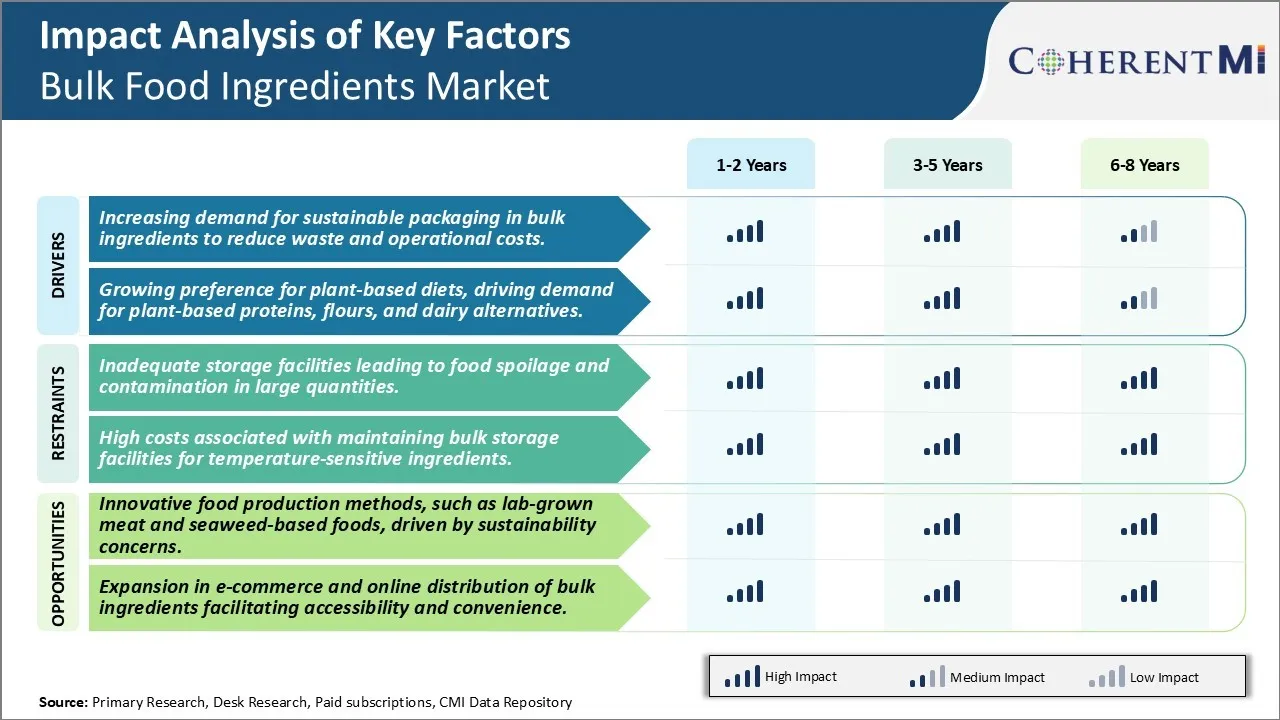Bulk Food Ingredients Market Trends
Market Driver - Increasing Demand for Sustainable Packaging in Bulk Ingredients to Reduce Waste and Operational Costs
The bulk food ingredients industry has been witnessing a noticeable shift toward more sustainable packaging solutions in recent years. With growing environmental consciousness among both manufacturers and consumers, companies are actively seeking ways to reduce plastic and packaging waste at various stages of production and distribution. Sustainable packaging made from recycled or renewable materials allows producers to lower their carbon footprint substantially. It also helps cut costs associated with traditional packaging over the long run.
Transitioning to recyclable and compostable bulk packaging provides tangible benefits to all stakeholders involved. For instance, suppliers of ingredients such as flour, dry fruits and nuts can reduce expenditure on single-use plastic packaging by opting for reusable containers made from eco-friendly materials. This translates to significant savings considering the large volumes packaged and shipped. Moreover, sustainable packages are more durable which further decreases replacement and disposal expenses. On the customer end, sustainable packaging eliminates secondary waste at grocery stores and food processing facilities. It streamlines recycling and improves efficiency in waste management.
From a social perspective, sustainable choices in bulk packaging resonate well with the changing values of younger consumers. Many recognize their ability to drive positive change through responsible shopping habits. By promoting waste reduction and circular economy, packaging innovations help food companies strengthen their environmental and social credentials. This enhances brand loyalty in the current marketplace that is increasingly aware of the climate impact of business practices. Government regulations are also getting stricter on plastic use and carbon footprint targets. Transitioning to sustainable models early allows first movers to gain a competitive edge in the evolving policy landscape.
Market Driver - Growing Preference for Plant-Based Diets, Driving Demand for Plant-Based Proteins, Flours, And Dairy Alternatives
Rising health consciousness and concerns over sustainability have boosted interest in plant-based diets significantly in recent times. More people now wish to reduce or eliminate animal products from their nutrition. This shift in lifestyle and value system has spurred strong demand for various plant-based food ingredients that can substitute animal-based equivalents. Ingredients such as soy, pea, lentil and chickpea proteins are being widely incorporated in both packaged retail products as well as food service menus to meet the needs of flexitarians and vegans.
In parallel to protein alternatives, the demand for plant-based milks and yogurts is rising at an exponential rate. Almond, oat, coconut, cashew and soy are some of the most popular plant milks being produced and distributed in bulk formats. Rising lactose intolerance and veganism have encouraged innovators to explore native plant-based ingredients as well. Teff, millet, sorghum and amaranth are new-age grains garnering attention for their nutritional attributes and versatility in baking and cooking applications.
As the appeal of healthy, sustainable plant-based diets grows multifold, food companies are proactively expanding their range of similar ingredient options. Catering to this movement provides a lucrative business opportunity and access to the growing market segment of health-conscious flexitarians. It strengthens positioning around Corporate Social Responsibility and appeals to younger, ethically-driven consumers. With more innovative plant-based solutions emerging constantly, the bulk food ingredients industry is poised to benefit tremendously from this transformational shift in global food systems and mass buying behavior.

Market Challenge - Inadequate Storage Facilities Leading to Food Spoilage and Contamination in Large Quantities
One of the key challenges faced by the bulk food ingredients market is inadequate storage facilities that can lead to massive food spoilage and contamination. As the bulk food supply chain involves large quantities of ingredients being stored and transported over long distances, proper cold storage infrastructure becomes extremely important. However, in many developing regions and even in some developed markets, lack of suitable refrigerated warehousing remains a major problem. Improper temperature and humidity control in storage facilities can rapidly accelerate the natural spoilage process in bulk foods like grains, pulses and meat products. This poses serious food safety risks and also results in significant monetary losses for suppliers due to wastage. Meeting consistently low temperature requirements over large volumes is also challenging without state-of-the-art cold stores. Addressing cold chain gaps through strategic investments in modern warehousing infrastructure can help boost efficiency while safeguarding public health.
Market Opportunity- Innovative Food Production Methods, Such as Lab-Grown Meat and Seaweed-Based Foods, Driven by Sustainability Concerns
One of the major opportunities for the bulk food ingredients market lies in innovative production methods that are being driven by sustainability and ethical considerations. For instance, the development of lab-grown or cultured meat using cell biology techniques provides an alternative to conventional livestock farming. If produced at commercial scale, cultured meat could reduce dependence on resource-intensive animal agriculture while satisfying growing demand for meat. There is also rising interest in alternative plant-based and algae-derived ingredients. The mass cultivation of seaweeds and microalgae offers scope for producing protein-rich and nutritious foods with a much lower environmental footprint than traditional meat proteins. While commercialization challenges remain, these novel food technologies have the potential to revolutionize future food systems and open up new revenue streams within the bulk ingredients sector if successfully developed and adopted by manufacturers and consumers.